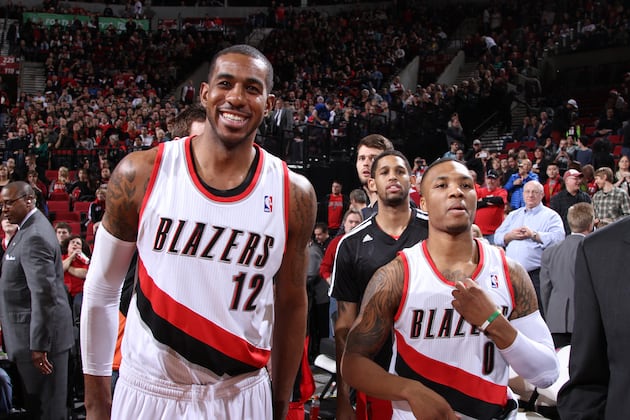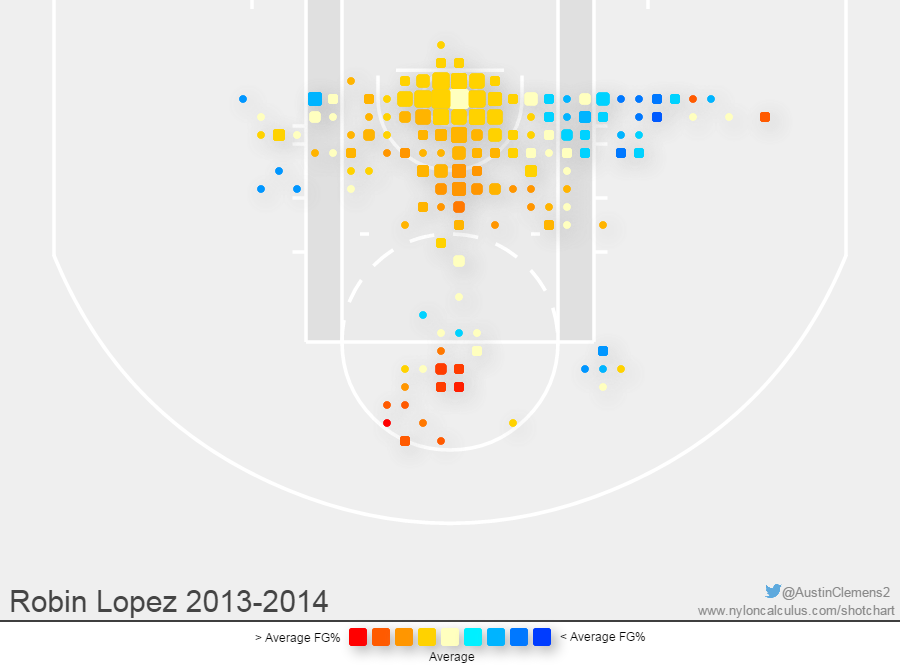 |
| LaMarcus Aldridge & Damian Lillard (Sam Forencich/Getty Images) |
The preseason conversations concerning LaMarcus Aldridge’s impending 2015 free agency seem to be much quieter this year compared to last. Aldridge submitted his most successful season in 2013-14, setting career-highs in points and rebounds per game, but the success of the Portland Trail Blazers is probably the best indicator as to his future preferences next summer in free agency.
Whatever frustrations that came out of Aldridge’s camp last summer seemed to revolve largely around basketball reasons, and the team’s back-to-back seasons of playoff-less basketball. Since Brandon Roy retired prior to the start of the 2011 (lockout) season the team finished a combined 26 games under-.500, and selected 11th in the 2012 Draft and 10th in 2013. The selections of Meyers Leonard and C.J. McCollum, respectively, have yet to pan out, but general manager Neil Olshey’s 2012 trade of Gerald Wallace to the then-New Jersey Nets for a Top 3-protected draft pick would provide Aldridge with an All-Star pick-and-pop partner in point guard Damian Lillard.
Chad Buchanan - Gerald Wallace for #6 pick (Lillard) MT @p_boogie1 what is best move made by a GM in the past 10 years
— Daryl Morey (@dmorey) March 25, 2014
Lillard was named Rookie of the Year in 2012-13 (over Anthony Davis) and led the league in total minutes, scoring 19 points per game on 43% shooting. His point and rebound averages increased in 2013-14, along with his three-point and free throw attempts and percentages, but his assist numbers dipped by playing more off-the-ball in lineups with Mo Williams or McCollum.
The overall quality of the team improved in ’13-14, as Olshey bolstered the young core of Lillard, Wes Matthews, Nic Batum, and Aldridge with veteran free agents Williams, Earl Watson, Dorell Wright, and Robin Lopez. Watson only appeared in 24 games but was a good locker room guy who retired after 12 years, and now coaches for San Antonio’s Developmental League affiliate. Wright started 13 games, averaging 14.5 minutes and 5 points per game, while Mo “Gotti” averaged under 10 points per game on 41.7% shooting and gave the Blazers another ball-handling option off of the bench.
Center Robin Lopez stabilized the Portland frontcourt, starting all 82 games and averaging 11.1 points, 8.5 rebounds, and 1.7 blocks per game on 55% from the floor. His presence directly impacted LaMarcus Aldridge and allowed him to play his most amount of minutes at power forward since 2009. Aldridge played as many as 54% of his 3,211 minutes at the center spot in 2010-11 but only 14% there last season (in almost 2,500 minutes), thanks to Lopez. He’s gone on record that he wants to “still prove that [he’s] the best power forward in the game”, and having a capable center to back him up on defense and take up space around the basket allows Aldridge to play to his strengths.
Aldridge’s game is predicated on the mid-range jump shot, which he’ll shoot off the catch from pick-and-pops/rolls or from post-ups. His jump shot is nearly un-block-able, as he uses his almost-7’5” wingspan and high release point to shoot over defenders, and he’s gotten smarter and improved his footwork every year since entering the league. He increased his proficiency from the mid-range but has yet to add a consistent three-point shot to his arsenal, despite years of talking about it. As a result his efficiency numbers have never rated as elite, and he actually posted the lowest true shooting and effective field goal percentages of his career last season (50.7 and 45.9%, respectively) despite peaking at 23.8 points per game. He’s efficient at taking his long jumpers – as he converted his long-2’s (16+ feet) at a 44.2% clip – but his success rate on his other two-point attempts fell from the year prior. While he doesn’t necessarily space the floor all the way to the three-point line, he’s still an effective stretch option who’s strong enough to set the high screen or able to swing the ball to the three other shooters in the starting lineup (Dame, Wes, and Nic).
LaMarcus led the team in scoring for the fourth-consecutive season, but in 2013-14 the Portland Trail Blazers increased their win total by 21 games and finished with the second-best offense in the league, with 111.5 points scored per-100 possessions. The defense struggled in the bottom-10 for most of the season but ultimately ended at 16th, at 107.4 points allowed (per 100 possessions). Portland would go 8-9 in March and drew the Houston Rockets in the first round of the NBA playoffs, where LaMarcus Aldridge would immediately express his dominance, especially from mid-range.
Game 1 of the first round series against the Rockets was Aldridge’s finest performance, with him firing from all spots on the court. He would finish with a 46-point, 18-rebound, 2-assist, and 2-steal stat-line before fouling out in overtime, but drew 13 free throws, made 17 of his 31 shots, and converted both of his three-point attempts in the victory. From the opening tip he hit the offensive glass and bothered shots on defense, using his size to completely body the smaller Terrence Jones. Houston would switch Dwight Howard onto him to make him work a little harder on offense, but Game 2 saw similar results, with LMA even more locked in.
He followed up his 46-point performance with 43 points (on 28 shots), 8 boards, and 3 blocks in the second game of the series, another Portland win that saw the Blazers go up 2-0 in Houston. It took the third game for Houston to alter its starting lineup (and style of play), swapping Jones for the seven-foot Omer Asik. The burlier Asik helped to hamper Aldridge’s scoring, holding him to 23/10/3 on 22 shots in Game 3. His worst game of the series, by far, came in Game 5 in Houston, where he went 3-12 from the field and finished with an 8/8/4 line, but in a close-out Game 6 win he dropped a 30/13 and drew 13 free-throw attempts, although he shot 10-26 from the field. Portland trailed by two points before Lillard would hit the enormous, iconic game-winner at the buzzer, lifting the Blazers out of the first round for the first time since the 2000 playoffs (and the pre-“Jail Blazers” teams!)
The second-round series versus the San Antonio Spurs was almost an afterthought, as the Spurs completely overpowered the more-inexperienced Portland team for the first three games and won the series in five. Aldridge was still dominant - putting up a 32/14 in Game 1, 16/10 in Game 2, 21/12 in Game 3, a 19/4 in Game 4, and a 21/10 in the 22-point close-out victory by the Spurs – but not Spurs-dominant.
Thankfully last season was so productive for both parties, as the LMA trade talk would be unbearable now that Kevin Love’s situation is finally settled. Instead of rampant trade rumors or free agency noise, LaMarcus has already laid out his timeline to re-sign for the five-year maximum-contract in free agency of 2015 (as the new CBA has limited veteran-contract extensions). Fellow-Blazers Wes Matthews, Dorell Wright, and Robin Lopez are also free agents next summer who the Blazers will look to retain, but Matthews’s negotiations could be fascinating in an NBA-landscape where Chandler Parsons and Gordon Hayward are worth max-contracts.
Worst-case scenario and all of their free agents are overpaid by other teams, including Aldridge, Olshey could decline a couple of team options and have somewhere around $30 million committed to next seasons’ roster, with an expanding salary cap in the wake of the massive new television deal. That five-year, “Derrick Rose” deal would presumably go to Lillard when they negotiate his extension next summer, and Olshey would have to rebuild his front-court in free agency with the $30-plus million in potential cap space.

LaMarcus Aldridge is already discussing his desire to retire as the greatest Blazer ever, which seems like a good sign for Portland’s chances to re-sign their star power forward. Entering his 9th season in the NBA, he’s already doubled the length of Bill Walton and Maurice Lucas’s Blazer careers and outscored both Rasheed Wallace and “Uncle” Clifford Robinson on the list of all-time Blazers power forwards. Aldridge sits third in the franchise’s 45-year history in points scored, and is a little more than 7,000 behind Hall of Famer Clyde Drexler. Another 1,600-point season and a five-year extension could put him within realistic reach of “The Glide”, which he also factored into his timeline.
Even if he never approaches Drexler's 18,000 points, LaMarcus Aldridge’s talk of legacy and his place within the Portland Trail Blazers’ history books is encouraging for the franchise and its fans going forward. If he can build upon his breakout-playoff performance in the series against the Rockets, and embrace his Rasheed Wallace comparisons as a potential long-armed defender and long-range shooter, Aldridge can claim that “best power forward” crown as soon as this season. When he re-signs with the Portland Trail Blazers next summer, LaMarcus Aldridge will be in position to claim the "greatest Trail Blazer" crown as well.


No comments:
Post a Comment